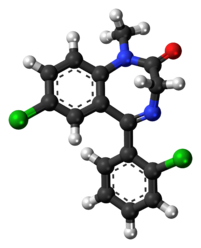Diclazepam
 | |
 | |
| Clinical data | |
|---|---|
| Routes of administration | Oral, sublingual |
| Legal status | |
| Legal status |
|
| Pharmacokinetic data | |
| Bioavailability | ? |
| Metabolism | Hepatic |
| Elimination half-life | ~42 hours[2] |
| Excretion | Renal |
| Identifiers | |
| |
JSmol) | |
| |
| |
| | |
Diclazepam (Ro5-3448), also known as chlorodiazepam and 2'-chloro-diazepam, is a benzodiazepine and functional analog of diazepam. It was first synthesized by Leo Sternbach and his team at Hoffman-La Roche in 1960.[3] It is not currently approved for use as a medication, but rather sold as an unscheduled substance.[4][5][6][7] Efficacy and safety have not been tested in humans.
In animal models, its effects are similar to diazepam, possessing long-acting
Metabolism
Metabolism of this compound has been assessed,[2] revealing diclazepam has an approximate elimination half-life of 42 hours and undergoes N-demethylation to delorazepam, which can be detected in urine for 6 days following administration of the parent compound.[8] Other metabolites detected were lorazepam and lormetazepam which were detectable in urine for 19 and 11 days, respectively, indicating hydroxylation by cytochrome P450 enzymes occurring concurrently with N-demethylation.
Legal status
United Kingdom
In the UK, diclazepam has been classified as a Class C drug by the May 2017 amendment to The Misuse of Drugs Act 1971 along with several other benzodiazepine drugs.[9]
United States
On December 23, 2022, the DEA announced it had begun consideration on the matter of placing Diclazepam under temporary Schedule I status.[10]
Later on July 25, 2023, the DEA published a pre-print notice that Diclazepam would become temporarily scheduled as a Schedule I controlled substance from 07/26/2023 to 07/26/2025.[11]
See also
- Diazepam
- Difludiazepam
- Delorazepam (Nordiclazepam)
- Lorazepam
- Phenazepam
- Ro09-9212
- Ro5-4864 (4'-Chlorodiazepam)
- Ro07-5220 (6'-Chlorodiclazepam)
References
- ^ Anvisa (2023-03-31). "RDC Nº 784 - Listas de Substâncias Entorpecentes, Psicotrópicas, Precursoras e Outras sob Controle Especial" [Collegiate Board Resolution No. 784 - Lists of Narcotic, Psychotropic, Precursor, and Other Substances under Special Control] (in Brazilian Portuguese). Diário Oficial da União (published 2023-04-04). Archived from the original on 2023-08-03. Retrieved 2023-08-16.
- ^ PMID 24604775.
- ^ US 3136815, "Amino substituted benzophenone oximes and derivatives thereof"
- PMID 27366870.
- PMID 27685473.
- PMID 29582576.
- S2CID 247455284.
- S2CID 1574555.
- ^ "The Misuse of Drugs Act 1971 (Amendment) Order 2017".
- DEA. December 23, 2022.
- DEA. July 25, 2023. Retrieved 2023-07-25.
